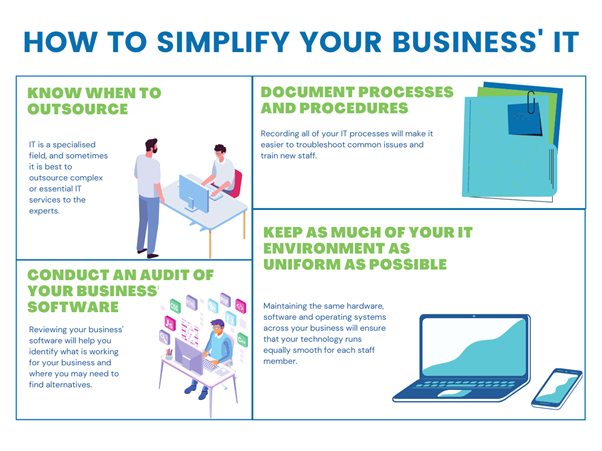How To Simplify Your Business’ IT
November 4, 2022
Technology can offer so much value to your business; it can increase efficiency, increase revenue, provide valuable data to guide business decisions, and improve customer engagement.
However, it is important to keep your IT simple to avoid complex systems that are difficult to manage.
Simplifying your IT is an ongoing process, but it can ensure that it runs smoothly and is able to adapt to changing business needs. To get you started in this process, we have compiled a list of tips to simplify your existing IT infrastructure.

Know When To Outsource
As much as we try, business owners simply cannot do it all. IT is a specialized field, therefore if your business is facing complex IT issues or relies on IT to do business (such as e-commerce businesses), it may be worthwhile outsourcing your IT management.
Your business could consider hiring an in-house IT manager or outsource to an external IT managed service provider depending on your business’ needs. Whilst you sometimes may be able to get the job done yourself, it will likely cost you a lot of time and you may be unknowingly implement inefficient processes.
Document All Your Processes And Procedures
Your business should take the time to record all relevant IT processes and store them somewhere it is easy for yourself and your staff to access. These processes should include how to use necessary programs as well as common IT errors and how to fix them.
In doing this, you and your staff will have documented process that can help you troubleshoot IT issues when they arise. In addition, it will also support the onboarding process for any new staff, as you will have a cache of documented processes they can read and refer back to.

Keep As Much Of Your IT Environment As Uniform As Possible
Managing the IT in your business will be a lot easier if everyone has the same hardware, operating system, and software. If you can maintain a unified IT environment, it will be a lot easier for your business to identify solutions to common problems.
In addition, it will ensure that the computers and software run equally smooth for every staff member.
Conduct An Audit Of Your Business’ Software
Unless you implemented all of your software with a digital transformation strategy in mind, you may have found yourself with an array of programs that are not the best fit for your business. To audit your software, ask yourself the following questions for each program your business uses:
- What do I use this program for?
- Does the program easily do what I need it to do?
- Does it connect seamlessly with other programs?
- Do I need to engage in workarounds to get my desired outcome?
These questions will get you thinking about your programs, and whether they are providing you with value and making your life easier. If they are not, research similar software to replace it with one that works for your business.

Acknowledgement Of Country
Business Foundations acknowledges the traditional custodians throughout Western Australia and their continuing connection to the land, waters and community. We pay our respects to all members of the Aboriginal communities and their cultures; and to Elders both past and present.
Victoria
The Commons
80 Market Street,
South Melbourne VIC 3205
admin@businessfoundations.com.au
Western Australia
Wesley Central
2 Cantonment Street,
Fremantle WA 6160
admin@businessfoundations.com.au


Get In Touch
Have a question or to find out how we can help you, please get in touch.






